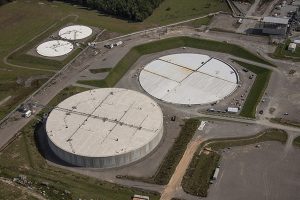
CAUTION urged to future well drillers at what was once the Savannah River Site and Idaho National lab – vaults with radioactive waste may lurk below! Subsurface material disposed of as “Waste Incidental to Reprocessing” (WIR) in concrete vaults with a soil cap may be penetrated by drilling, posing a risk of released of radioactive materials.
US Nuclear Regulatory Commission report: “IMPLICATIONS OF DOMESTIC WATER WELL DRILLING PRACTICES FOR INADVERTENT INTRUDER SCENARIOS”
Prepared for U.S. Nuclear Regulatory Commission
Office of Nuclear Material Safety and Safeguards
Division of Decommissioning, Uranium Recovery,
and Waste Programs
Contract No. 31310018D0001
Task Order No. 31310018F0077 (Task Area 4)
George Adams and Gordon Wittmeyer
Center for Nuclear Waste Regulatory Analyses
San Antonio, Texas
– posted in the NRC’s digital library (ADAMS) on January 25, 2021 – linked here: https://adamswebsearch2.nrc.gov/webSearch2/main.jsp?AccessionNumber=ML20349G094
domestic water well drilling practices near Idaho National Laboratory (INL) and the
Savannah River Site (SRS) to support U.S. Nuclear Regulatory Commission (NRC) reviews of
waste-incidental-to-reprocessing determinations by the U.S. Department of Energy (DOE).
NRC reviews focus on evaluating near-surface waste disposal performance assessment (PA)
models used by DOE to estimate expected radiation doses for comparison with performance
objectives in Title 10 of the Code of Federal Regulations (10 CFR) Part 61. A hypothetical
intruder scenario is considered in PAs conducted in accordance with NRC low-level radioactive
waste (LLW) performance objectives at 10 CFR 61.42 that are applicable to NRC
waste-incidental-to-reprocessing reviews. NRC requested that CNWRA examine existing water
well drilling technologies to determine whether any of these have the potential to penetrate the
thick reinforced concrete covers and steel tank liners that function as intruder barriers for LLW
and residual waste disposed at INL and SRS. NRC further directed the CNWRA to survey
domestic water well drillers who operate in the vicinities of INL and SRS to determine the type of
drilling methods they use, the actions they take if they drill into unexpected hard rock and
metallic material, and their experience, if any, encountering metal objects, such as rebar in
reinforced concrete. In addition, the CNWRA was directed to ask the drillers whether and what
type of personal protective equipment (PPE) (e.g., dust masks) their drill crews wear, for acute
exposures, how many total hours the drill crew operates the drill rig, and how drill cuttings are
managed during and after drilling. CNWRA staff surveyed six water well drillers from the INL
area and seven from the SRS area. Seven of the 13 drillers have experienced drilling into
reinforced concrete and plate steel. Of these seven drillers, four continued to drill and penetrate
the rebar or plate steel, while three moved their drill rigs and started new boreholes. Near INL,
water wells require 60 to 70 hours to drill. Near SRS, water wells are shallower than at INL, the
formations are more easily penetrated, and a typical well can be drilled in six to eight hours.
None of the surveyed drillers have their crew wear breathing protection while on site. In
addition to surveying drillers, this study reviewed the hydrogeology near INL and SRS and water
well drilling regulations in Idaho and South Carolina. The information gathered and presented in
this report can help in understanding current well drilling practices and evaluating the adequacy
of DOE PAs for waste-incidental-to-reprocessing reviews.
DOE photo: radioactive waste disposal units at SRS , to be filled with grout and capped and covered with soil and left forever